

Keys Are The Sure Way To Build Songs!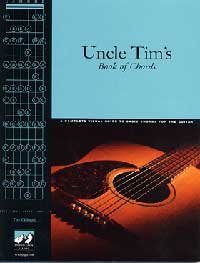
Keys seem to be the hidden ingredient to playing a guitar. Once you know keys you can immediately start playing the chords in the key and constructing songs based on the chords in the key.
Triads are the simplest chords you can create and they flow up and down the fretboard providing easy access to any chord in any key with hardly any effort.
And when you are constructing a song, there is no better tool available anywhere. And the knowledge you get will set you free!
There is nothing like it and nothing that can make composing songs as easy as this. For $20, you can have a resource that will always show you all the choices for where you are working. Pick up a copy today.
eBooks are delivered instantly!
by Tim Gillespie
 In
past columns we have looked at diatonic and pentatonic scales and simple
triads embedded within the diatonic signature. I have often espoused the
virtues of examining scale and chord groups within the visual confines
of a signature. But so far we have only looked at the above mentioned
signatures. This month we are going to extend the reach of signatures
to examine another scale and some additional chords.
In
past columns we have looked at diatonic and pentatonic scales and simple
triads embedded within the diatonic signature. I have often espoused the
virtues of examining scale and chord groups within the visual confines
of a signature. But so far we have only looked at the above mentioned
signatures. This month we are going to extend the reach of signatures
to examine another scale and some additional chords.
One of the best uses for these signatures is they provide the big pictures of the information inside a concept. To illustrate let's talk about the diatonic signature for C major. If you look at the signature for the key of C major and A minor you will quickly be able to run down all the available pathways and notes. If you want to construct something in a diatonic key, all the options can quickly be considered.
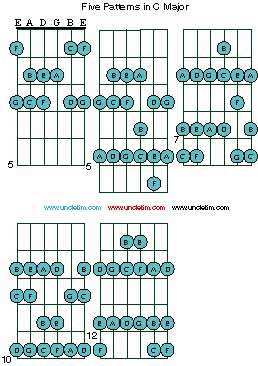 I
have noticed a few posts in some newsgroups lately that talk about how
there are only five scale forms you have to know to understand diatonic
scales. This is a partial truth. True, there are five distinct scale forms
that can be tied to a diatonic key, however, there are many more pathways
available for construction. And eventually you will want to break out
of a simple pattern and grab notes from other patterns. Creative phrases
are not limited to a specific pattern. You may find that you want to climb
higher than any of these patterns allow by themselves. Remember the standard
five patterns are listed here but these five patterns are not the only
ones available. If you study the diatonic signature you can easily see
this.
I
have noticed a few posts in some newsgroups lately that talk about how
there are only five scale forms you have to know to understand diatonic
scales. This is a partial truth. True, there are five distinct scale forms
that can be tied to a diatonic key, however, there are many more pathways
available for construction. And eventually you will want to break out
of a simple pattern and grab notes from other patterns. Creative phrases
are not limited to a specific pattern. You may find that you want to climb
higher than any of these patterns allow by themselves. Remember the standard
five patterns are listed here but these five patterns are not the only
ones available. If you study the diatonic signature you can easily see
this.
These are the typical patterns that are discussed when people talk in terms of "the five patterns". It is common to see some notes substituted, so you may see alterations of these. Here is an example to the right.
There are many more examples of substitutions available and most of them are covered in past columns. The point is if you look at twelve fret signatures they are all included. An important point to remember is the twelve fret signature repeats every twelve frets, so this is all you have to memorize to have it all.
 Here is a link to the April
edition of this newsletter if you would like to review the diatonic
signature and the basic concepts behind it.
Here is a link to the April
edition of this newsletter if you would like to review the diatonic
signature and the basic concepts behind it.
Triads In A Key
Scales are only one half of the uses of a signature. The other half are chords. The basic building blocks of chords are triads. Triads are chords in their most basic form. In order to be considered a chord, three notes must be present. If only two notes are present, it is considered an interval.
So now let's look at how triads are embedded in the diatonic signature. As I have said before, all chords for the key of C major are in the signature for C major. The only exception to this are chords that contain a note outside the key. An example is C7, which contains a Bb note. Bb is not in the key of C major.
Triads are the simplest chords available. They are composed of only three notes, the one, three and five notes which, of course, make up a chord.
You can chop the signature into four, three string sets and start to examine triads. Here is an example. Notice the four three string sets start with the lowest three strings and as they progress from left to right, drop the lowest string while adding the next highest string.
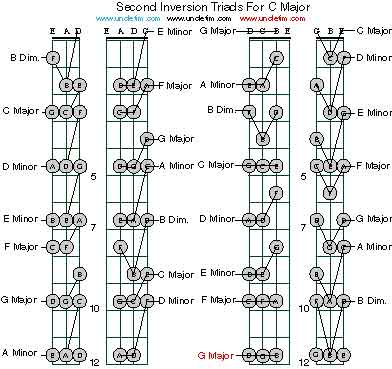 This
example splits the diatonic signature into four, three string sets. These
are second inversion triads for the key of C. They are in fact all the
second inversion triads for consecutive strings for the key of C major.
They can also be applied to all the other keys if you work a little. Please
notice that you can use nonconsecutive strings and create other triads.
They are still in the signature.
This
example splits the diatonic signature into four, three string sets. These
are second inversion triads for the key of C. They are in fact all the
second inversion triads for consecutive strings for the key of C major.
They can also be applied to all the other keys if you work a little. Please
notice that you can use nonconsecutive strings and create other triads.
They are still in the signature.
It may not be obvious by looking, but there is quite a bit of information here that translates into extreme power when dealing with chords. Study this and you should begin to see lots of relationships emerge. As I have said before, the fretboard is quite orderly and complex.
Notice the G major chord in red. It is the same G major chord that occurs at the open strings. Remember everything repeats twelve strings higher. Everything!
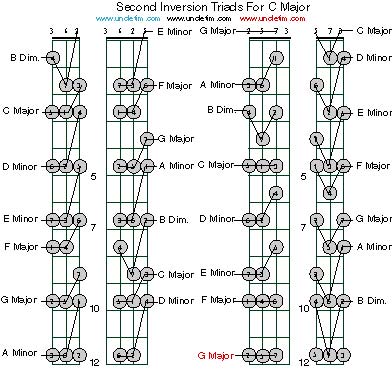 This
diagram uses numbers instead of letters. It can be helpful to examine
notes in terms of degrees when building chords.
This
diagram uses numbers instead of letters. It can be helpful to examine
notes in terms of degrees when building chords.
C = 1
D = 2
E = 3
F = 4
G = 5
A = 6
B = 7
These are the degrees of the scale.
To build chords just connect the degrees that make up the chord. Use every other note until you accumulate three notes. Here is an example.
For the C major chord use the 1, 3 and 5 notes.
D minor = 2, 4, 6
E minor = 3, 5, 7
F major = 4, 6, 1
G major = 5, 7, 2
A minor = 6, 1, 3
B dim = 7, 2, 4
If you look at the numbers and go down the columns, you can see that
each chord starts with the next number in sequence. C major starts with
1, D minor starts with 2, etc..
You can do the same thing for the other two inversions as well. The point of this is to show you how complete the twelve fret signature is. It literally contains everything in the key. Using numbers can make the construction process similar to connecting the dots.
Up to this point we are only discussing the basic ingredients of diatonic keys. As I said earlier in the summer we are going to go beyond basic diatonic concepts and start to expand into more advanced concepts. This is the entry point for this more advanced conversation. There will be more to come in future columns.
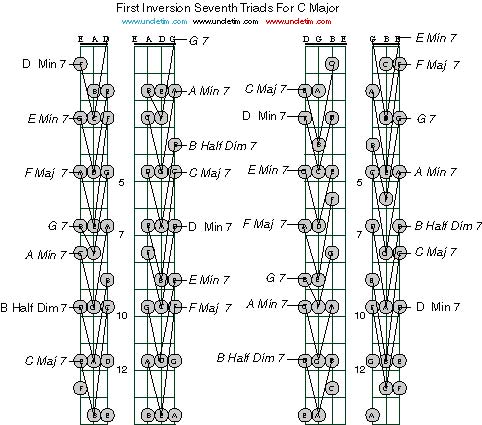 So
here are some other chords that are nicely hidden in the twelve fret signature.
These are first inversion seventh triads for the key of C. I included
first inversion seventh triads because they are easier to play then second
inversion triads.
So
here are some other chords that are nicely hidden in the twelve fret signature.
These are first inversion seventh triads for the key of C. I included
first inversion seventh triads because they are easier to play then second
inversion triads.
Keep in mind there are seventh chord triads. Usually seventh chords are described as four note chords. They are usually constructed using the 1, 3, 5 and 7 degrees. When these advanced chords are constructed, thirds are stacked on top of one another. This technique can introduce notes outside of the key. Again an example of this is the C 7 chord which stacks a minor third on top of a major chord to construct the C 7 chord. This is also something that will will examine in later columns.
There are thousands more chord forms available if you take the time to look and apply the rules of music. These examples are taken from Book 4 of The Uncle Tim Series for the guitar(the next release) This is the first time that I have used them in this newsletter.
There are a couple of helpful hints for working with these chords I would like to pass on. First of all, you can play them just like you would play scales. Alphabetically! Start with the D min 7, then climb through the alphabet. You can climb up the three string set or across the fretboard. Below you will see an example of climbing across the fretboard. I call that playing three note scales.
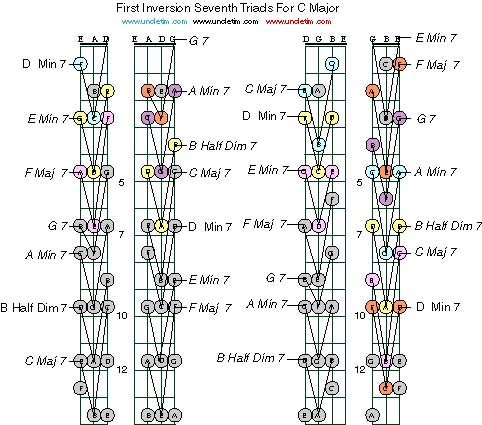 Notice
the colored dots highlight different chords. These chords flow up and
across the fretboard The progression starting on the low E string is D
min 7,
Notice
the colored dots highlight different chords. These chords flow up and
across the fretboard The progression starting on the low E string is D
min 7,
E min 7,
F major 7, (go to the next set),
G 7,
A minor 7,
B half dim 7, (go to the next set).
C major 7,
D minor 7, (go to the next set),
F major 7,
G 7,
A minor 7,
B half dim 7,
C major 7 and
D minor 7.
In effect you are playing three note scales using seventh triads. Of course there are other ways to play these chords. You can stick to one set of three strings and climb up the fretboard without changing string sets. Or you can choose to jump to another string set at other locations. In "The Need For Speed" we will experiment with this.
Next thing to notice is, you can pick only the chords you want to use and start to build progressions. You do not have to play these in order, but for initial practice it is a great way to warm up.
Next you should also see there are alternative pathways you can use when playing alphabetically. You do not have to switch strings where I have indicated. You can choose to climb higher and then switch. There are several choices.
Finger assignments can and should vary. Try different combinations using all four fingers (two of three fingers at a time) and also try barring these triads to provide a workout for your index finger. You can also barre with your second or third fingers once you start to get the hang of this. This will greatly increase finger strength and dexterity.
And finally realize these progressions do not stop at the twelfth fret. They continue to repeat as you climb higher up the fretboard. They are available on every fret of the guitar.
So hopefully this should help you start to explore chords in relation to the twelve fret signature. With some work, you may be able to work within the big picture and examine details at the same time. I find this approach to be very helpful. Also don't forget to combine this with scale exercises to help your mind connect the two concepts. They work hand in hand!
Other Signatures

 So far everything we have studied comes from the diatonic
signature. In past issues we have also looked at the pentatonic signature.
In fact any rules for scales or keys can be expressed using a signature.
The diatonic and pentatonic keys are only two examples. Now I would like
to introduce another signature.
So far everything we have studied comes from the diatonic
signature. In past issues we have also looked at the pentatonic signature.
In fact any rules for scales or keys can be expressed using a signature.
The diatonic and pentatonic keys are only two examples. Now I would like
to introduce another signature.
This is the Blues scale for A minor. The construction starting on the tonic note in a minor key is whole step + half step, whole step, half step, half step, whole step + half step, whole step.
This discussion could very quickly go deep into theory but that would go beyond what this column is trying to accomplish. However, it will be the sole subject for next month. That will be a very advanced column and it will cover some very heavy theory. For now the point is the Blues scale can be expressed with a signature too just as any other scale can.
If you are interested in Blues scales, you may want to try to carve some patterns out of this signature. This is a good opportunity to play with this signature and pick out some patterns to practice with. Just remember to proceed alphabetically and use convenient finger assignments. You may soon find signatures are very easy to work with, and offer a complete picture of the subject. In later issues we will explore different keys and concepts using this tool. For now, this should give you plenty to think about.
I suggest starting with compressed patterns. Here is an example of what I mean. Of course you can always try anything in this signature but for now I would keep it simple. If you want to hang with the discussion next month, I suggest you look at this closely. We are going to test some unusual concepts and they are very complex.